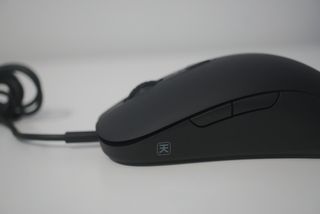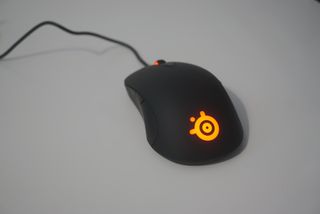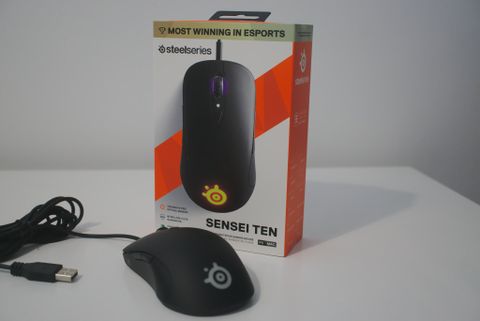
If you've come across the SteelSeries Xai mouse that was out in 2009, this new Sensei Ten will look familiar. That's because SteelSeries kept the same shape, reportedly down to the millimeter, but added modern features, including a brand new TrueMove Pro sensor.
Is it as good as (or better than) the excellent Rival 600? I took the new Sensei Ten for a test drive to see just how good this refreshed mouse is.

$70 at AmazonBottom line: The Sensei Ten pays tribute to a classic mouse with a ridiculously good sensor.
For
- Amazing TrueMove Pro sensor
- Comfortable to use
- Solid build quality
- Profile storage
Against
- Design a tad bland
- Non-detachable cable
What you'll love about the SteelSeries Sensei Ten

The Sensei Ten is named after the Sensei's 10th anniversary. As aforementioned, this is an interesting launch since the new Sensei Ten uses the same classic shape as the SteelSeries Xai, released ten years ago. Fans of the Sensei, ranging from amateur gamers to the professionals, have been calling for its return, and SteelSeries obliged.
The SteelSeries Sensei Ten keeps the classic design with a killer new sensor.
SteelSeries wasn't just content with re-releasing the Sensei as is, but instead wanted to take it to the next level with a fancy new sensor and additional features. It's this new TrueMove Pro sensor that stands out, co-engineered with PixArt. It's incredible, especially given the price of the Sensei Ten.
This fancy piece of technology packs some additional benefits that place this mouse in the same playing field as the SteelSeries Rival 600 for performance, including tilt tracking and a higher threshold for controlling ripple. The former helps detect when you're quickly lifting the mouse off and back down on the surface.


| Category | Spec |
|---|---|
| Sensor | Optical TrueMove Pro |
| CPI | 50-18,000 |
| IPS | 450+ |
| Acceleration | 50G |
| Poll rate | 1000Hz |
| H/w acceleration | - |
| Materials | ABS plastic |
| Weight | 92g |
| Buttons | 8 |
| Storage | ✓ |
| Grips | Claw Fingertip Palm |
Better controlling ripple effects is great for those who prefer using mice at high calculations per inch (CPI) settings, which can cause a small amount of jitter to occur as the sensor attempts to keep up. The TrueMove Pro doesn't require any ripple control until around 5,000 CPI, resulting in butter-smooth performance for most users. Speaking of which, the CPI can be configured between 50 and 18,000.
Other handy features added to the Sensei Ten include onboard profile storage, allowing you to configure the mouse how you like and have it save the settings to memory — perfect for LAN parties. The weight has also been reduced to just 92g but feels comfortable to wield and solid in-game. The switches are also rated for 60 million clicks.
All this makes for a compelling gaming mouse. It's durable, being made of hard polymer plastic, SteelSeries rates its switches to last for years, and it houses a rock-solid sensor. Possible grips include claw, fingertip, and palm. Lastly, there are a total of eight programmable buttons, including the main two clickers.
What's more is the new Sensei sports a comfortable ambidextrous design, allowing both lefties and right-handed gamers to enjoy the excellent pointer performance.
What you'll dislike about the SteelSeries Sensei Ten

The Sensei is a classic, and this is a great revival with a genuinely astounding sensor, but the new Sensei Ten isn't without its faults. The design and build quality of the Sensei Ten is a flawlessly symmetrical ambidextrous look, but the company took away the previous Sensei colors in favor of matte black.
Most peripherals are black these days, but it would have been good to see at least some design elements added, like a pattern effect on the side grips. It's fine-looking but just plain. That said, how often do you look at your pointer?
There's also no wireless option yet, but I imagine SteelSeries may look at this for the Sensei Ten. Speaking of wires, the one connected to the Sensei Ten cannot be detached — this I do not like.
So should you buy the SteelSeries Sensei Ten?

The classic Sensei mouse was loved by many for its performance, look and feel. SteelSeries kept the same design, made it feel even more comfortable to use, and threw in its most advanced pointer sensor. The performance rivals that of more pricey pointers.
It's not perfect. Some may prefer a wireless option (should one eventually become available), while others may not find the design to be particularly enticing. If you can overlook these minor flaws, you'll be able to enjoy using a superb gaming mouse, though there are probably more compelling mice out there at this price.

An excellent value gaming mouse
SteelSeries did something exceptional by taking a classic design and packing it full of modern features with a genuinely fantastic sensor.

Rich Edmonds was formerly a Senior Editor of PC hardware at Windows Central, covering everything related to PC components and NAS. He's been involved in technology for more than a decade and knows a thing or two about the magic inside a PC chassis. You can follow him on Twitter at @RichEdmonds.
